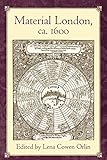Material London, ca. 1600 / ed. by Lena Cowen Orlin.
Material type: TextSeries: New Cultural StudiesPublisher: Philadelphia : University of Pennsylvania Press, [2012]Copyright date: ©2000Description: 1 online resource (400 p.) : 52 illusContent type:
TextSeries: New Cultural StudiesPublisher: Philadelphia : University of Pennsylvania Press, [2012]Copyright date: ©2000Description: 1 online resource (400 p.) : 52 illusContent type: - 9780812217216
- 9780812208399
- 942.105/5
- DA680 ǂb M38 2000eb
- online - DeGruyter
- Issued also in print.
| Item type | Current library | Call number | URL | Status | Notes | Barcode | |
|---|---|---|---|---|---|---|---|
 eBook
eBook
|
Biblioteca "Angelicum" Pont. Univ. S.Tommaso d'Aquino Nuvola online | online - DeGruyter (Browse shelf(Opens below)) | Online access | Not for loan (Accesso limitato) | Accesso per gli utenti autorizzati / Access for authorized users | (dgr)9780812208399 |
Frontmatter -- Contents -- Illustrations -- 1. Introduction -- Part I. Meanings Of Material London -- Introduction -- 2. London's Dominion: The Metropolis, The Market Economy, And The State -- 3. Material London In Time And Space -- 4. Poetaster, The Author, And The Perils Of Cultural Production -- Part II. Consumer Culture : Domesticating Foreign Fashion -- Introduction -- 5. England's Provinces: Did They Serve Or Drive Material London? -- 6. Fantastical Colors In Foggy London: The New Fashion Potential Of The .Latesixteenth Century -- 7. "Rugges Oflondon And The Diuell's Band": Irish Mantles And Yellow Starch As Hybrid London Fashion -- 8. Women, Foreigners, And The Regulation Ofurban Space In Westwardho -- Part III. Subjects Of The City -- Introduction -- 9. Material Londoners? -- 10. Purgation as the Allure of Mastery: Early Modern Medicine And The Technology Ofthe Self -- II. London's Vagrant Economy: Making Space For "Low" Subjectivity -- Part IV. Diversions And Display -- Introduction -- 12. Inside/Out Women, Domesticity, and the Pleasures of the City -- 13. The Authority oft he Globe and the Fortune -- 14. Building, Buying, and Collecting in London, 1600-1625 -- Part V. Building the City -- Introduction -- 15. The Topography and Buildings of London, ca. 1600 -- 16. John Day and the Bookshop That Never Was -- 17. Boundary·Disputes in Early Modern London -- Contributors -- Acknowledgments -- Index
restricted access online access with authorization star
http://purl.org/coar/access_right/c_16ec
Between 1500 and 1700, London grew from a minor national capital to the largest city in Europe. The defining period of growth was the period from 1550 to 1650, the midpoint of which coincided with the end of Elizabeth I's reign and the height of Shakespeare's theatrical career.In Material London, ca. 1600, Lena Cowen Orlin and a distinguished group of social, intellectual, urban, architectural, and agrarian historians, archaeologists, cultural anthropologists, and literary critics explore the ideas, structures, and practices that distinguished London before the Great Fire, basing their investigations on the material traces in artifacts, playtexts, documents, graphic arts, and archaeological remains.In order to evoke "material London, ca. 1600," each scholar examines a different aspect of one of the great world cities at a critical moment in Western history. Several chapters give broad panoramic and authoritative views: what architectural forms characterized the built city around 1600; how the public theatre established its claim on the city; how London's citizens incorporated the new commercialism of their culture into their moral views. Other essays offer sharply focused studies: how Irish mantles were adopted as elite fashions in the hybrid culture of the court; how the city authorities clashed with the church hierarchy over the building of a small bookshop; how London figured in Ben Jonson's exploration of the role of the poet.Although all the authors situate the material world of early modern London-its objects, products, literatures, built environment, and economic practices-in its broader political and cultural contexts, provocative debates and exchanges remain both within and between the essays as to what constitutes "material London, ca. 1600."
Issued also in print.
Mode of access: Internet via World Wide Web.
In English.
Description based on online resource; title from PDF title page (publisher's Web site, viewed 24. Apr 2022)


